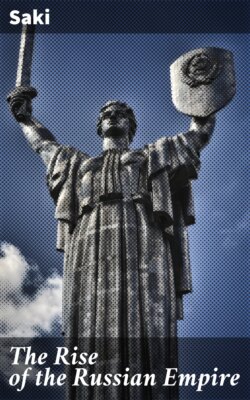The Rise of the Russian Empire

Реклама. ООО «ЛитРес», ИНН: 7719571260.
Оглавление
Саки. The Rise of the Russian Empire
The Rise of the Russian Empire
Table of Contents
PREFACE
WORKS CONSULTED
LIST OF MAPS
CHAPTER I. THE DAWN OF RUSSIAN HISTORY
CHAPTER II. THE COMING OF THE VARANGIANS AND THE BUILDING OF KIEVIAN RUSSIA
CHAPTER III. THE FEUDS OF THE HOUSE OF RURIK
CHAPTER IV. THE COMING OF THE MONGOLS
CHAPTER V “THE YEARS THAT THE LOCUST HATH EATEN”
CHAPTER VI. THE GROWING OF THE GERM
CHAPTER VII. THE LAST OF THE PALEOLOGI AND THE FIRST OF THE AUTOCRATS
CHAPTER VIII. IVAN GROZNIE
CHAPTER IX. THE GREAT BOYARIN
CHAPTER X. THE PHANTOM TZAR
CHAPTER XI “THIS SIDE THE HILL”
GLOSSARY. OF RUSSIAN WORDS EMPLOYED WITHOUT EXPLANATION IN TEXT
INDEX
FOOTNOTES
Отрывок из книги
Saki
Published by Good Press, 2019
.....
Russia, which is blessed with a rich variety of tribes and peoples, the despair of the ethnographical geographer, who can scarcely find enough distinctive colours wherewith to denote them all on his maps, is characterised by a singular uniformity of physical conditions throughout the greater part of its huge extent. Geographically speaking, it is difficult to determine what are the exact limits of the region known as Russia-in-Europe, the Oural Mountains, which look such an excellent political barrier on paper, being really no barrier at all, certainly not what is known as a scientific frontier. As a matter of fact they are less a range of mountains than a chain of low table-lands, having precisely the same conditions of soil, flora, and fauna on either side of them. Zoologically the valley of the Irtuish forms a much stronger line of demarcation, but much of Russia west of the Ourals coincides more nearly in physical aspect with the great Asiatic plain than it does with the remainder of Europe. Southward and westward from this fancy boundary stretches a vast expanse of salt, sandy, almost barren steppe-land; this gives way in time to large tracts of more or less fertile steppe, partaking more of the character of prairie than of desert, bearing in spring and early summer a heavy crop of grasses, high enough in places to conceal a horse and his rider. Merging on this in a northerly direction is the “black-soil” belt, a magnificent wheat-growing country, which well merits the title of the Granary of Europe. Northward again is a region of dense forest, commencing with oaks and other deciduous trees, and becoming more and more coniferous as it stretches towards the Arctic circle, where pine and fir disappear, and give way to the Tundras, moss-clad wastes, frozen nine months out of the twelve, the home of reindeer and Samoved. Over all this wide extent the snows and frosts of the Russian winter fall with an almost equal rigour, though for varying duration of time. Except on the east, the country possesses strongly-marked natural boundaries; on the south-east rises the huge pile of the Kaukasus Mountains, flanked east and west by the Kaspian and Black Seas respectively; on the south-west lie the Karpathians, while from north-west to north the Baltic is almost connected by lake, swamp, and the deep fissure of the White Sea with the Arctic Ocean. Broadly speaking, nearly the whole area enclosed within these boundaries is one unbroken plain, intersected and watered by several fine rivers, of which the Volga and the Dniepr are, historically, the most important. This, then, is the theatre on which was worked out the drama of Russian national development.
It will now be necessary to glance at the racial and political conditions which prevailed at the period when the curtain rises on mediæval Russian history. First as to the ethnology and distribution of the Slavs, a branch of whom was to be the nucleus round which the empire of all the Russias was to gather. The lore of peoples and of tongues has enabled scientists to assign to the Slavs a place in the great Aryan family from which descended the stocks that made their dwelling on European soil. Exactly when their wanderings brought them into their historic home-lands it is difficult to hazard, nor is it possible to do more than speculate as to whence they came in that distant yesterday of human spate and eddy. At the epoch when Russian history, in a political sense, may be said to start into existence (the commencement of the ninth century), the distribution of the Slavs is more easy to trace; with the exception of an offshoot in the south-east of Europe, occupying Servia, Dalmatia, Croatia, and Slavonia, they appear to have been gathered in a fairly compact though decentralised mass in what may be termed North Central Europe. Holstein, Mecklenburg, and Pomerania, roughly speaking, formed the country of the Wends; another group, the Czechs and Poles, inhabited Bohemia, Moravia, and Poland; while a fourth body, destined to become the most important, was established in North-west Russia, hemmed in by Finns on the north, Turks and Avars on the east and south. These latter Slavs, the germ of the future Russian nation, lived in tribal communities in the midst of the mighty forests of oak, pine, birch, willow, etc., which stood thick around the basin-lands of the Upper Dniepr, Dvina, and Volkhov, and the source of the Volga. These dense fastnesses they shared with the wolf, boar, lynx, fox, bear, beaver, elk, aurochs, deer, otter, squirrel, and marten, which latter especially furnished them with a valuable article of commerce, the Russian marten skins being highly prized in the fur markets of Europe. Seals abounded on their sea-coast and in Lake Ladoga; the numerous swamps were the home of the wild goose, swan, and crane; the eagle, hawk, raven, cuckoo, and daw were familiar to them, while pigeons were early domesticated among their dwellings.
.....